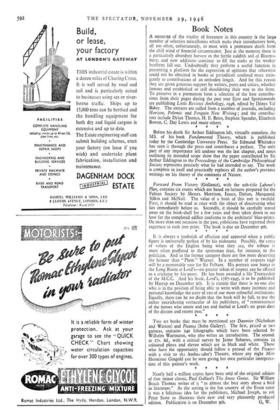Book Notes
A MEASURE of the vitality of literature in this country is the large number of selective miscellanies which make their introductory bow, all too often, unfortunately, to meet with a premature death from the chill wind of financial circumstance. Just at the moment there is a particularly abundant harvest in the fertile reddish soil of Blooms- bury, and new additions continue to fill the ranks as the weaker brethren fall out. Undoubtedly they perform a useful function in presenting a platform for the expression of opinions that otherwise could not be obtained in books or periodicals confined more strin- gently to contributions of an orthodox length. And for this reason they are given generous support by writers, poets and critics, whether famous and established or still shouldering their way to the front. To preserve in a permanent form a selection of the best contribu- tions from their pages during the past year Eyre and Spottiswoode are publishing Little Reviews Anthology, 1946, edited by Denys Val Baker. The extracts are culled from a number of journals, including Horizon, Polemic and Penguin New Writing ; and the contribu- tors include Dylan Thomas, H. E. Bates, Stephen Spender, Elizabeth Bowen, C. Day Lewis and many others.
* *
Before his death Sir Arthur Eddington left, virtually complete. the MS. of his book Fundamental Theory, which is published today by the Cambridge University Press. Sir Edmund Whittaker has seen it through the-press and contributes a preface. The only part of any importance left undone was the last chapter, and notes outlining its intended scope show that the paper contributed by Sir Arthur Eddington to the Proceedings of the Cambridge Philosophical Society represents precisely what he had intended to say. The work is complete in itself and practically replaces all the author's previous writings on his theory of the constants of Nature.
* * Forward From Victory (Gollancz), with the sub-title Labour's Plan, contains six essays which are based on lectures prepared for the Fabian Society by Messrs. Morrison, Isaacs, Dalton, Marquand, Silkin and McNeil. The value of a book of this sort is twofold. First, it should be read at once with the object of discovering what lies immediately before us. Secondly, it should be carefully stored away on the book-shelf for a few years and then taken down to see how far the completed edifice conforms to the architects' blue-prints. On more than one occasion in the past, politicians have regretted their eagerness to rush into print. The book is due on December 9th. * * * * It is always a yardstick of affection and approval when a public figure is universally spoken of by his nickname. Possibly, the sense of values of the English being what they are, the tribute is more often proffered to the sportsman than, for instance, to the politician. And in the former category there are few more deserving the honour than " Plum " Warner. In a number of respects 1946 will be a memorable year for Sir Pelham. His portrait now hangs in the Long Room at Lord's—no greater token of respect can be offered to a cricketer by his peers. He has been awarded a life Trusteeship of the M.C.C. And his book, Lord's, 1787-1945, is to be published by Harrap on December 9th. It is certain that there is no one else who is in the position of being able to write with more intimate and personal knowledge the story of one of our more colourful institutions. Equally, there can be no doubt that the book will be full, to use the rather uncricketing vernacular of his publishers, of " reminiscences of the heroes who smote and ran and hurled at Lord's on great days of the distant and recent past." * * * * Two art books that must be mentioned are Daumier (Nicholson and Watson) and Picasso (Soho Gallery). The first, priced at two guineas, contains 240 lithographs which have been selected by Wilhelm Wartmann, who also writes an introduction. The second, at 27s. 6d., with a critical survey by Jaime Sabartes, contains 24 coloured plates and eleven which are in black and white. Those who have the opportunity should follow a perusal of the Picasso with a visit to the Ambas•ador's Theatre, where any night Miss Hermione Gingold can be seen giving her own particular interpreta- tion of this painter's work. * * * Nearly half a million copies have been sold of the original edition of that minor classic, Paul Gallico's The Snow Goose. Sir William Beach Thomas writes of it " as almost the best story about a bird in literature." As the setting is the fen country of the Essex coast it was a felicitous idea for the publishers, Michael Joseph, to ask Peter Scott to illustrate their new and very pleasantly produced edition. Publication is on December 9th. G, W.


































 Previous page
Previous page